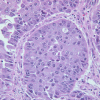Leukemoid reaction and autocrine growth of bladder cancer induced by paraneoplastic production of granulocyte colony-stimulating factor--a potential neoplastic marker: a case report and review of the literature
- PMID: 24885603
- PMCID: PMC4055228
- DOI: 10.1186/1752-1947-8-147
Leukemoid reaction and autocrine growth of bladder cancer induced by paraneoplastic production of granulocyte colony-stimulating factor--a potential neoplastic marker: a case report and review of the literature
Abstract
Introduction: Granulocyte colony-stimulating factor produced by nonhematopoietic malignant cells is able to induce a leukemoid reaction by excessive stimulation of leukocyte production. Expression of granulocyte colony-stimulating factor and its functional receptors have been confirmed in bladder cancer cells. In vitro studies have demonstrated that granulocyte colony-stimulating factor/receptor exhibits a high affinity binding and this biological axis increases proliferation of the carcinoma. Urothelial carcinoma of the bladder is rarely associated with a leukemoid reaction and autocrine growth induced by paraneoplastic production of granulocyte colony-stimulating factor. In the world literature, there have been less than 35 cases reported in the last 35 years. The clinicopathological aspects, biology, prognosis and management of granulocyte colony-stimulating factor-secreting bladder cancers are poorly understood.
Case presentation: A 39-year-old Caucasian woman with an invasive high-grade urothelial carcinoma presented with hematuria and low-grade fevers. Laboratory tests revealed an elevated white blood cell count and absolute neutrophil count and an elevated 24-hour urine protein. Upon further evaluation she was found to have locally advanced high-grade urothelial carcinoma without nodal or distant metastasis. Her serum granulocyte colony-stimulating factor level was 10 times the normal limit. This led to the diagnosis of a paraneoplastic leukemoid reaction. Her white blood cell count immediately normalized after cystectomy but increased in concordance with recurrence of her disease. Unfortunately, she rapidly progressed and expired within 10 months from the time of first diagnosis.
Conclusions: This is one of the few cases reported that illustrates the existence of a distinct and highly aggressive subtype of bladder cancer which secretes granulocyte colony-stimulating factor. Patients presenting with a leukemoid reaction should be tested for granulocyte colony-stimulating factor/receptor biological axis. Moreover, granulocyte colony-stimulating factor could be a potential neoplastic marker as it can follow the clinical course of the underlying tumor and thus be useful for monitoring its evolution. Neoadjuvant chemotherapy should be considered in these patients due to the aggressive nature of these tumors. With a better understanding of the biology, this autocrine growth signal could be a potential target for therapy in future.
Figures




Similar articles
-
Autocrine growth of transitional cell carcinoma of the bladder induced by granulocyte-colony stimulating factor.Cancer Res. 1995 Aug 1;55(15):3438-43. Cancer Res. 1995. PMID: 7542171
-
[A case of bladder carcinoma representing leukemoid reaction].Nihon Hinyokika Gakkai Zasshi. 1993 Feb;84(2):382-5. doi: 10.5980/jpnjurol1989.84.382. Nihon Hinyokika Gakkai Zasshi. 1993. PMID: 8464190 Review. Japanese.
-
[Bladder cancer producing granulocyte colony-stimulating factor (G-CSF): a case report].Hinyokika Kiyo. 2002 Aug;48(8):495-8. Hinyokika Kiyo. 2002. PMID: 12243077 Review. Japanese.
-
Granulocyte colony-stimulating factor receptor signals for beta1-integrin expression and adhesion in bladder cancer.Urology. 2004 Jan;63(1):177-83. doi: 10.1016/s0090-4295(03)00786-6. Urology. 2004. PMID: 14751388
-
[Bladder carcinoma producing granulocyte colony stimulating factor (G-CSF). A case report].Nihon Hinyokika Gakkai Zasshi. 1994 Jul;85(7):1135-8. doi: 10.5980/jpnjurol1989.85.1135. Nihon Hinyokika Gakkai Zasshi. 1994. PMID: 7521443 Review. Japanese.
Cited by
-
Serum G-CSF May Be a More Valuable Biomarker than Image Evaluation in G-CSF-Producing Urothelial Carcinoma: A Case Report.Case Rep Oncol. 2017 Apr 24;10(1):377-382. doi: 10.1159/000472250. eCollection 2017 Jan-Apr. Case Rep Oncol. 2017. PMID: 28559823 Free PMC article.
-
Paraneoplastic Leukemoid Reaction in Gastroesophageal Junction Adenocarcinoma: A Case Report.Am J Case Rep. 2020 Jan 31;21:e919596. doi: 10.12659/AJCR.919596. Am J Case Rep. 2020. PMID: 32001665 Free PMC article.
-
Cytokine Measurements for Diagnosing and Characterizing Leukemoid Reactions and Immunohistochemical Validation of a Granulocyte Colony-Stimulating Factor and CXCL8-Producing Renal Cell Carcinoma.Biomark Insights. 2018 Aug 17;13:1177271918792246. doi: 10.1177/1177271918792246. eCollection 2018. Biomark Insights. 2018. PMID: 30147294 Free PMC article.
-
Granulocyte Colony-Stimulating-Factor-Producing Bladder Carcinoma: A Case Report and Literature Review.Cureus. 2025 May 4;17(5):e83447. doi: 10.7759/cureus.83447. eCollection 2025 May. Cureus. 2025. PMID: 40462819 Free PMC article.
-
Trousseau's syndrome caused by bladder cancer producing granulocyte colony-stimulating factor and parathyroid hormone-related protein: A case report.Oncol Lett. 2016 Nov;12(5):4214-4218. doi: 10.3892/ol.2016.5152. Epub 2016 Sep 20. Oncol Lett. 2016. PMID: 27895794 Free PMC article.
References
-
- Tachibana M, Miyakawa A, Tazaki H, Nakamura K, Kubo A, Hata J, Nishi T, Amano Y. Autocrine growth of transitional cell carcinoma of the bladder induced by granulocyte-colony stimulating factor. Cancer Res. 1995;55:3438–3443. - PubMed
-
- Demetri GD, Griffin JD. Granulocyte colony-stimulating factor and its receptor. Blood. 1991;78:2791–2808. - PubMed
-
- Sato K, Terada K, Sugiyama T, Masuda H, Kakinuma H, Kato T. Granulocyte colony-stimulating factor produced by bladder carcinoma of a patient with leukemoid reaction did not affect proliferation of the tumor cells. J Urol. 1994;151:1687–1690. - PubMed
Publication types
MeSH terms
Substances
LinkOut - more resources
Full Text Sources
Other Literature Sources
Medical

